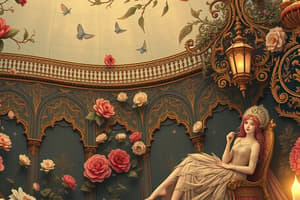Podcast
Questions and Answers
What distinguishes a representational artwork from a non-representational artwork?
What distinguishes a representational artwork from a non-representational artwork?
How does an artisan's work differ from an artist's work in the context of art appreciation?
How does an artisan's work differ from an artist's work in the context of art appreciation?
Which of the following statements about the emotional content of 'The Scream' by Edvard Munch is true?
Which of the following statements about the emotional content of 'The Scream' by Edvard Munch is true?
What was a primary focus of Renaissance art?
What was a primary focus of Renaissance art?
Signup and view all the answers
What role do Filipino artisans play in their cultural heritage?
What role do Filipino artisans play in their cultural heritage?
Signup and view all the answers
Study Notes
Art Appreciation: Subject, Content, Artist, and Artisan
-
Subject: The "what" we see in an artwork. This is the literal representation, object, or person depicted.
-
Content: The "why" – the meaning, emotion, or story behind the artwork. Context and intent play a crucial role.
-
Artist: Creates to express emotions or ideas. Focuses on the conceptual and expressive elements of a work.
-
Artisan: Crafts functional items with an artistic touch. Examples include pottery, weaving, and furniture. Prioritizes both beauty and practicality.
Types of Subject Matter
-
Representational Art: Realistic depictions of people or objects.
-
Non-Representational Art: Abstract representations; focuses on colors, shapes, and emotions instead of recognizable objects.
Content in Art - The "Why"
-
Content: The emotion, story, or symbol behind the artwork.
-
Example: The Scream by Edvard Munch showcases intense anxiety.
Levels of Meaning in Content
-
Factual: The literal story or visuals.
-
Conventional: Cultural symbols and meanings.
-
Subjective: Personal interpretations by the viewer.
Artisans and Functional Content
-
Artisan's Work: Combines function and beauty.
-
Example: A potter crafts a vase that is both decorative and functional.
Similarities and Differences Between Artists and Artisans
-
Artists: Express ideas or emotions; provoke thought or feeling.
-
Artisans: Create functional beauty; focus on everyday, useful items.
-
Similarities: Both require skill, creativity, and dedication.
Historical Examples and Context
-
Renaissance Art: Focused on beauty, idealism, and human potential.
-
Filipino Artisans: Preserve cultural heritage through crafts like weaving and pottery.
Studying That Suits You
Use AI to generate personalized quizzes and flashcards to suit your learning preferences.
Related Documents
Description
Explore the essential concepts of art appreciation, focusing on the subject, content, artist, and artisan distinctions. This quiz dives into the types of subject matter and the underlying meanings embodied in artworks. Test your understanding of representational and non-representational art forms along with their emotional significance.



